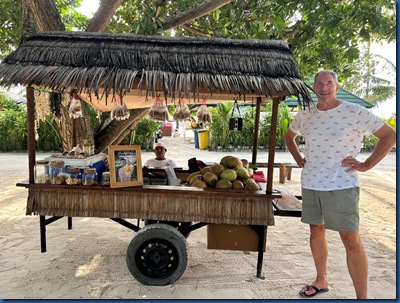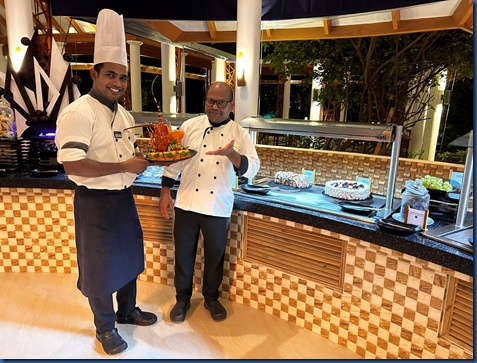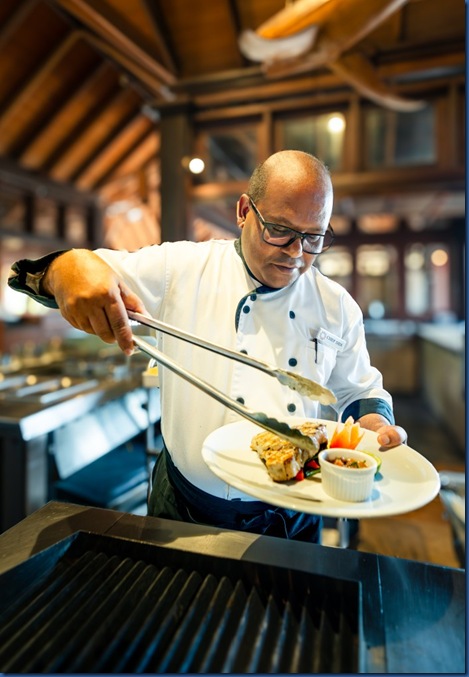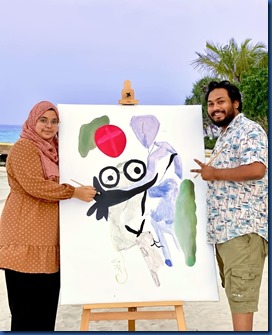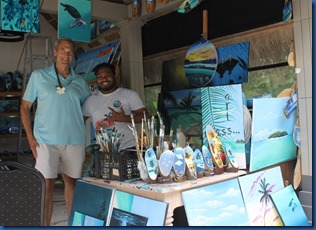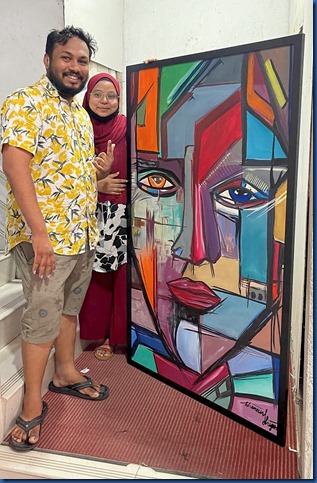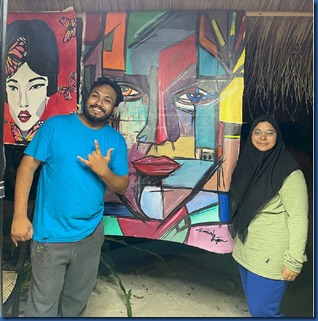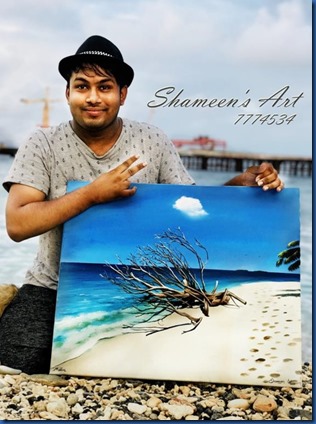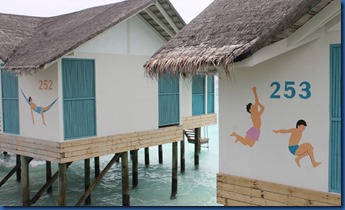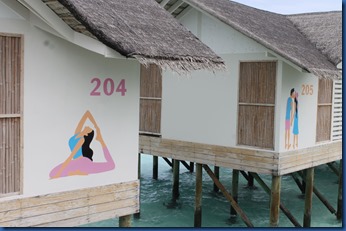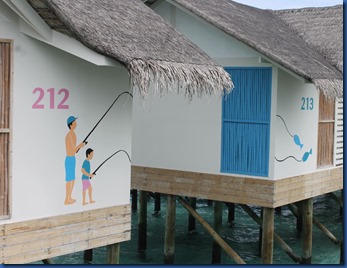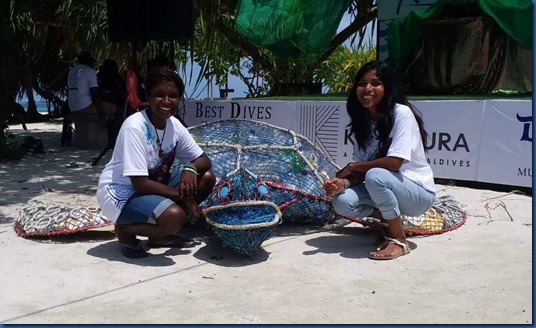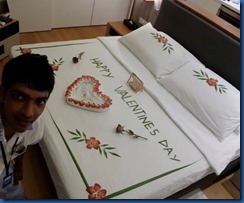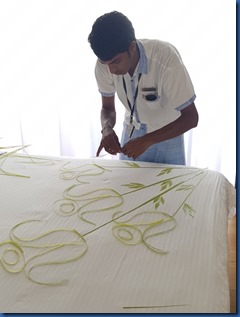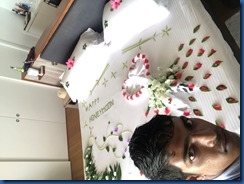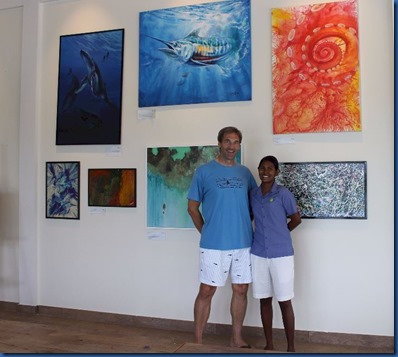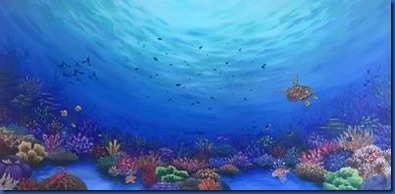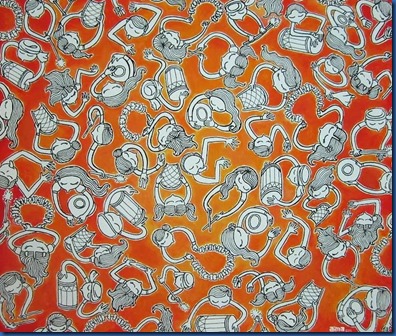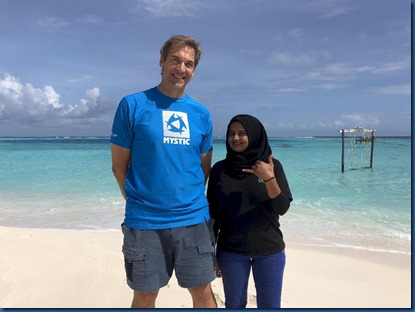On most islands, landscaping staff will readily find a coconut for you direct from the trees, and some resorts have special stands to serve up free coconut, but at Siyam World guest get their coconut the Maldivian way. Coconut stands are the equivalent of the “water cooler” on local islands where locals gather to chat and hang out. Not only does Siyam World have a typical coconut stand, but they also recruited an actual coconut seller from a nearby island who was lured out of retirement to take his trade to the resort.
Best of the Maldives: Veteran Chef – Sun Siyam Olhuveli
As the Maldives tourism industry matures, a number of veterans of the sector stand-out with some serious tenure. As the industry started dominated by ex-pat workers and management, Maldivian national veterans are a bit rarer. Sun Siyam Olhuveli’s Executive Chef Didi Hassan is the longest serving Maldivian I have met in the Maldives. He has been in the business for 32 years, 10 years of which have been at Olhuveli. That pedigree has given him a distinctive perspective on the evolution of the sector, milestone events (especially the tsunami of 2004), and insight into effective resort management and operations. I had the opportunity to sit down with him during my recent visit and glean some of these reflections.
How did you start your career?
I started my career peeling potatoes. I’m not even in the kitchen. I’m at the back door of the kitchen. I took an onion and garlic and started doing that. Then I after another month, I told my chef I wanted to go inside the kitchen. He gave me a chance and allowed me to come into the kitchen. He started by giving me a knife and doing some cutting. But he gave me a very unsharp knife. He said, “If I give you a proper knife, you’re going to cut your hand”…So I started cutting there. I tried to be very fast because my intention was to finish any thing I got to do as quickly as possible and then get something else to do.
How did you develop your culinary expertise?
I started hotel school training in culinary. I did learning little by little. But I had no target, no direction. But my direction was shaped by working in the kitchen. Back then you didn’t have phones, computers and laptops everywhere. We had one or two computers in the front office. If you wanted to do something on them, you had to go get permission. So, in order to learn, I started collecting magazines. When people checked out, they often left magazines behind. And there were lots of food articles. I would cut out all sorts of articles. This is part of learning. I would ask the room boys that if anyone leaves any magazine to give it to me. People would leave books to and any food-related book I would read.
In 1987 I was very young when I married. Me and my wife have had a very good connection from a very young time. Can’t say we were neighbors, but a not far from my home. We went to school and during that time I had some time to go work in a factory. In 1993, We got our first baby. And so that time ,I was here in Olhuveli. This is when I got serious in my work career. I thought about myself what I’m looking for in the industry. I decided my main target was to be an executive chef.
It was a very straightforward goal. Every year I checked how it was happening, what was happening, whether it is progressing or not progressing, figuring what is the next. Anytime I am on duty, I first person in the kitchen and last person in the kitchen. Because I know I have to show myself.
At 31, I became the chef at Oluhevli. We had only three restaurants. One is a buffet restaurant, one is a la carte restaurant and other one is a pool restaurant. At these three restaurants, we have a la carte restaurant and we have teppanyaki. I also worked for 5 years in teppenyaki. Back in 1993, there were no F&B managers like what we have now. But after about 2000, we started getting some high end resorts the operations got more sophisticated.
Do you cook for your family?
When I am visiting home, definitely, I will cook part of it. The children say, “Dad’s home! Please cook curry, chicken curry.” And they will ask for noodles, dry tuna noodles.” I also serve these dishes at the resort. I customize a lot of the local cuisine in the menus.
Do you have any advice for someone looking for a career in F&B?
Right now I manage 133 chefs. When I have interviewers, I ask “What’s your goal? What are you looking for? What is your vision?” You cannot get anything if you don’t put yourself into that goal that only you can achieve. Don’t give up any situation. Don’t look behind, go forward. My advice to anyone coming out of culinary school is first that you have to be punctual. To be on time. If the team isn’t on duty, we just can’t get the job done. Secondly, set your vision and mission as your target to be achieved and work for that.
What is your management style?
I don’t want anyone have a limit. So I don’t keep anyone to limit. You create what you think. Put what is on your mind on the plate or put on the paper and come and discuss it with me. I am looking for interesting dishes.
Do you have a chef’s garden?
The company has three agricultural islands. We decided on things like ladies fingers, eggplants, basils, mint, lemongrass as they are all very easy to grow. You can see that the soil is limited. When you dig it, after one foot, it will be salt water. It’s not easy to grow things, but I have still tried to plant in different things in different places like chili trees and lemon trees. So you become a bit of a farmer as well as a chef.
You were on the island during the tsunami. What was that like?
It was very early morning. And we had a huge departure scheduled with over 100 guests checking out and 90 guests arriving. So I came in very early that morning. I was with my breakfast team and I could see the huge lagoon (there was no Dream Island or Romance Island back then). Then, the whole air became totally different. It was like a feeling. Like a ghost. There was a kind of an unusual sound as well. Still we didn’t know what was going on, but you could see the darkness created. The wind direction changed, but still we are not seeing anything happening. Then when I saw the sea, there was no water. I asked our accountant, Barry, “What is happening?”
Then we had a very heavy strong ‘zoom’ sound. This started to feel a little bit scary. But still we didn’t know what was, but it felt scary. Still there was no water in the lagoon. It was totally empty. Then after that, you saw water start to come up from the sand. The water is boiling up like bubbles.
At that point, the ocean started coming in. First to the lagoon and then onto the island itself. At first, it was about 6 inches deep, but it pushed very strongly. You could not stand up. Then the water rose all the way up to the level of the restaurant roof! At the time, everyone was done with breakfast and people were out and about going to the beach, snorkeling, diving, doing activities. Then the second wave hit. It came in the same way, but this time it came from the side.
When it happened, an announcement was made for all the staff to go to the arrival area. We had almost 90 people on the jetty because the lagoon deck is a bit higher than anywhere else. Then we had security check every room to see if anyone was left there.
Fortunately, everyone was okay. We didn’t have any deaths though we had a few injuries. Immediately, we created a task force team. We divided into 4 or 5 groups. The powerhouse was shut down, but the computer system was still live. Somehow we were able to restart operations immediately.
Then it came to food. Most of our food stores were gone. Our chillers and freezers broke down, but they were floating on top of the water that came flooding in and they stayed sealed so a lot of that food was saved.
We collected all the tin items and checked whether we can use them. We arranged all the food we had. Engineering was working on restoring power. All the kitchen equipment was gone. Then we were able to do some cooking and the staff and the guest were fed together.
At this point we still didn’t know what was going on. We did start sending guests to the airport immediately. Some people had damaged passports from the water, but at that time the majority of rooms didn’t have safes so people kept their passports in the front office which kept them safe. By the following midnight, all the guests had left the island for the airport and only staff remained. But then the government sent guests to us who have gotten stranded. Almost 500 guests. 700 quarantine people in total.
The staff were allowed to go home if they could find a way to travel. We didn’t terminate any staff, but we couldn’t afford to pay them. We said you can stay here and we would feed and house them and give them some pocket money.
The people remaining all volunteered to help. We had a big task with all these things to do. And we had to feed 700 quarantined people.
You could walk freely, but you couldn’t come onto the island. There we police and military guarding the island entrance. We carried the food from the entrance and then we santise it.
Best of the Maldives: Underwater Stair Washer – Joali
Perhaps the most Maldivian of all the Maldivian jobs I’ve profiled, Joali’s Hussain takes BBC’s “Amazing Hotels” host Rob Rinder for an underwater apprenticeship in keeping the iconic water villas in tip top shape (note: video does not play in UK due to geoblocking).
Best of the Maldives: Artist Couple in Residence – Cora Cora
A number of resorts now feature artists-in-residence, but Cora Cora is the first husband-wife team plying their creativity in family partnership. I had the fortune to meet Shameen during our recent visit (see photo below) and he told me about his intriguing artistic journey. He and his wife Sheenez shared their story with Maldives Complete:
Shameen…
- How did you get started in art?
I started when I was young. When I was 7 years, my mother asked if I could draw this photo. I started with pencil. At that time, there were no art classes in the school on the local island. In the school, I was sketching on the paper. People asked if I could paint things for them. When I got to Grade 10, I got to be pretty good. There was a competition for the whole Maldives. I had to go into schools. The competition had a theme of Human Rights so we had to to represent things like domestic violence, etc. I received 3rd place. Then I came to Male. I looked for anybody who taught art, but there was nobody. People suggested going abroad, but I didn’t have the money for that. I continued studying diligently and I went to school for business management. I told my mother that I wanted to have 6 months to do what I wanted. I was 17 years old at the time. I spent all my money (500 rufia) to buy art supplies. I didn’t have good Internet so I went to the library to study books about art. I started painting portraits. I got lots of business doing pencil sketches. I study from my heart, because I love to do it. When I was 18, I wanted to do an exhibition, but I didn’t have the money. But someone saw my work who had a boutique at the Male airport. He also had a school and I started teaching at the school. I could paint a painting in under 8 minutes (and people enjoyed watching me do it). I have painted more than 30,000 paintings. At one point, I had to stop painting and I started driving a taxi, when one of the people I drove was the Director of Cora Cora (Martin). During the ride, I showed my work on the phone and he asked me to paint the Cora Cora paintings - Who are some of your favorite artists and influences?
My wife Sheeneez. She is a good observer so she guides me through making my work more perfect. She has lots of great ideas. - How did you meet?
When I was 17 years, I went library to gather information for an art class. I saw her in the library and saw this beautiful girl. I fell in love at first sight. So I decided to draw her face and give it to her. On the pictures, I wrote my phone number and gave it to her. She messaged me 6 months later and we have been together ever since. - How do your styles differ?
I am mastering in Water color, acrylic colour, Oil colour, Pencil color, Airbrush etc Last 10 years I was into all styles of the painting. I am more into realism style and she has a more modern style. - What is your aspiration?
I’ve opened an art school in Male to teach art to students of all ages. My dream is to grow young artists and give them hope in the art world. We also help with displaying and even marketing their art.
Sheeneez…
- How did you get started in art?
Sometime after we met, Shameen started a studio downstairs from my father’s store. I started helping him with the studio doing backgrounds, and eventually he taught me more and more about painting. - Who are some of your favorite artists and influences?
Shameen (obviously!). We teach together at the resort and in Male. I also like Larssen who does lovely dolphins. - How did you meet?
I had just moved to Male and went to the library with a friend. Within 5 minutes, this young man introduced himself to me. - Which is your favorite piece done by the Shameen?
A modern painting with lots of colours which was his first painting. This one is very special. - Which is your favorite piece done by you?
I never painted a person’s face with colour. So one day I decided to try it doing Bob Marley. I was very proud of it. I was surprised at how well it came out.
Best of the Maldives: Villa Paintings – Cora Cora
Cora Cora has decorated its villas with a bit of local artistry with a unique painting on everyone depicting some activity at the resort. The portraits were all painted by Maldivian artist Shameen who is now in residence at the resort (stay tuned).
Best of the Maldives: Maldivian Marine Biologists Women – Cocoa / Siyam World
There are so many Maldivian women to celebrate during International Women’s Week, that we had to feature to in one post. Kaia Mohamed Ali at Cocoa Island and Mariyam Thuhufa at Siyam World are two friends breaking glassfloors into the depths of marine biology in the Maldives. I had the chance to meet Kaia during my recent visit to Soneva Jani where she had previously been working and we shared all lively and insightful conversation about Laccadive life. She introduced me to her friend and colleague in the field, Mariyam, who at the time was working just a (long) stone’s throw away at Siyam World. They both gave Maldives Complete exclusive interviews about their personal and professional journeys to the undersea world…
Kaia Mohamed Ali:
- What atoll are you from?
I am from Kaafu atoll, from the capital city of Male’. - What age did you learn to swim?
I learnt to swim at the age of 4, but my parents would take me to dip in the sea when I was much younger. My parents felt it was important to teach me to be comfortable in the water since our country is surrounded by water. - What was your first snorkelling experience?
The first time I went snorkelling, I was 15 years old. I spent ages 7 through 14 living in Sri Lanka. After I returned to the Maldives, I went for my first snorkel with a friend on the house reef of Villimale’. It was a surreal experience as it was my first time seeing the reef with my own eyes – something I had previously only seen during the many hours I spent watching NatGeo and Animal Planet. Before my first snorkel, I always had a slight fear of the animals that lived in the ocean. I had only ever seen them from the surface or in the shallows. I was afraid of sharks, stingrays and moray eels and always felt I would get attacked. I guess the false portrayal of these movies played a role in my fear. After I started snorkelling and spending much time on the reef, I understood the behaviour of marine life. Nothing would hurt me as long as I knew how to behave in the water – No touching wildlife, no chasing wildlife, and no feeding wildlife. As long as you respected the animals’, everything was fine. - What was your first diving experience?
My first diving experience was after I started doing my degree foundation in Marine Science. I was 16 years old. I signed up for my open water course and went on a dive to Male’s reef. It was fun and less scary than I thought it would be. I enjoyed my experience. I noticed the difference between the coral life at the surface versus a few meters below. I knew at that moment that I would never stop diving. I did not notice the sewage pipes sticking out the reef on that same dive until it blasted the diver in front of me with sewage. Very disgusting. I never went diving on Male’ reef again. - Where did you study marine biology?
I studied Marine Biology at the Maldives National University. I am currently working in COMO Cocoa island as a resident marine biologist. I built up my resume through volunteer work and eventually worked for a non-profit in sea turtle conservation. Many years of work experience prepared me for the role of Marine Biologist. - What did you do your final research paper on?
Please refer to the previous answer. Although I did not do my final research paper, I have contributed to and conducted my independent studies during my time working, such as an internal scientific paper on the Sediment Dynamics on Olhuveli Island. - What is your favourite sighting diving?
It’s hard to pick a favourite when you’re fascinated by everything underwater! But one that stands out/that I can think of at the top of my head is when I dove at a Manta point in Laamu Atoll. We saw a handful of mantas along with massive green turtles – two animals I love. There was so much going on I wasn’t sure where to look. I equally enjoy the dives where I find the small stuff – the cute tiny shrimp and nudibranchs – they’re harder to find, therefore more rewarding. - What is your favourite sighting snorkelling?
I think it would have to be the first time I ever saw a Whale shark. I took a trip to South Ari atoll to spend time with the Maldives Whale Shark Research Programme for my birthday. After two weeks of no whale shark sightings in Ari Atoll, we saw three on my birthday. It was the first time I’d seen any marine life that massive. I can’t even describe the overwhelming feelings I felt. I definitely cried into my mask. A second favourite sighting was on a casual snorkel in Noonu atoll; I came across a lone eagle ray cruising by. As I dove down to take a closer look, he came up towards me, made direct eye contact and circled me. We spent a few seconds just swimming around each other before he finally swam off. It’s just incredible to me that we can have such intimate interactions with wildlife. - How did you and Mariyam meet?
Thuhufa and I initially met while she worked for a sea turtle conservation NGO called Naifaru Juveniles in Lhaviyani Atoll. I was working for a different sea turtle conservation non-profit called the Olive Ridley Project. I participated in a Turtle festival by the Naifaru Juvenile when we first met. I noticed Thuhufa as there weren’t many young locals working in conservation. It was nice to meet someone else with the same passions as me. We reconnected a few years later when we were enrolled for the same course in University. It was an instant connection – we became really close friends and we worked pretty closely during our time there. - What is the most prevalent misconception about the ocean and marine life that you find?
That sharks are dangerous and want to eat you. Despite their reputation – sharks are not dangerous and they don’t want to eat you. They would much rather feed on fish and other mammals. Humans are not part of their natural diet and they rarely attack humans. You are more likely to die because of a cow than by sharks.
Mariyam Thuhufa (here is another fine profile on Mariyam)
- What atoll are you from?
I am from R. Atoll Rasmaadhoo. A beautiful local island just north of Male’. The island is known for its Surf Spot and for the local boat buildings. It’s a small island with a big sense of community still intact. - What age did you learn to swim?
I can’t recall when exactly I learned how to swim. When I was living in my island I would have been around 6 or 7, I used to follow my cousins out to the water and we used to spend the day in the sea. I remember this one memory vividly. One day I followed my cousin brother to our islands famous surf spot. He went out on his board and I stayed near the beach. But at one point I wanted to get in to the water so I swam out. Next thing I know I was caught in the surf. I remember being under three consecutive waves and not being able to breath. I remember being terrified but I went back to the ocean the very next day. I guess, after that incident I unconsciously taught myself to swim, or at least how to not get caught in huge surfs. - What was your first snorkelling experience?
My first snorkeling experience was in the house reef of Villimale’. Villimale’ is the closest island to Male’ and was considered a picnic island back when I was a kid. I used to go there with my family on the weekends and started learning to snorkel during these trips. At first, I would stay in the shallow lagoon area and get excited whenever I see a lone fish passing by. One day I wandered off to the reef edge and it was the most beautiful sight I’ve ever seen. I saw lots of colorful corals and huge parrot fishes. This was way before the 2016 el Nino, so the reef was vibrant with healthy corals and lots of species of fish. It was an amazing experience. - What was your first diving experience?
My first diving experience was way back in 2014, when I was working at the Maldives Whale Submarine. How the submarine operated was that when the sub goes down with the passengers, scuba divers would go down with it and fool around with the fishes and eels and entertain the guests. I had always wanted to go dive with the scuba team. One day after much talking, one of the instructors from the team decided to take me for a discover scuba session. It was the most amazing day. I loved everything about my first dive. How the sun’s rays looked under the surface to how the eels came and wrapped themselves around me so gently. I loved discovering the smallest invertebrates that day and playing around with an octopus while it changed colour frequently. It was a day I will never forget. - Where did you study marine biology?
I did my bachelors in Environmental Management at Maldives National University. Most of my knowledge about the marine environment I have gained from working and volunteering at different NGOs. I am currently working at the newly opened 5-star resort SIYAM WORLD as their Resident Marine Biologist. But before I landed this job, I’ve worked with Maldives Whale shark Research Program, Turtle Rehabilitation center in Naifaru Juvenile, IUCN and I’ve done coral and fisheries research at Maldives Marine Research Institute. - What did you do your final research paper on?
My Final Research Paper was on the ‘Perception of Maldivian Grouper Fishers on the sustainability of the Current Practices and the Management Plan’. In my paper I did an in-depth analysis of the current practices of the grouper fishery industry of the Maldives and how effect the current management plan is on combating the unsustainable practices that has been going on in the industry. I also conducted a survey questionnaire to understand how well the fishers know about the management plan and tried to understand how their livelihood was being affected by the sustainability practices enforced in the management plan. - What is your favourite sighting diving?
It is so hard to pick one sight. But on the top of my head I think the best sight was when I was doing a fun dive at Vaavu Atoll a few years back and we came across a ball of trevallies. It was the most amazing thing. We went right inside the ball of fish so we were surrounded on all sides by them. This was something I’ve always wanted to experience and it was just so surreal. This was a dive I will never forget. - What is your favorite sighting snorkelling?
I think my favorite sight snorkeling would be anytime we get to interact with Mantas or Whlaesharks. Whalesharks specially are such gentle giants that we get to spend atleast 30 minutes with one and it just becomes such a meaningful experience because you get to learn so much about them during this interaction. - What is the most prevalent misconception about the ocean and marine life that you find?
There is a lot of them ranging from ‘corals are plants’ to ‘all sharks are dangerous’. Amongst fishers that I have talked to there is also the general idea floating about that since the ocean is so big, we will never run out of fish. I think this is the biggest misconception that I find, especially in the Maldives where our livelihood and food resource is so directly connected to the fisheries industry of the country. Fisherman thinking sustainability during fishing practices is unnecessary because they don’t believe in the declining fish stock populations while research clearly shows otherwise. This is why, currently there is a lot of effort put into conducting awareness sessions for the local fishers regarding issues like this.
Best of the Maldives: Room Decorating Instagram – Kuramathi
Kuramathi’s Waheed Saamid pentathlete of a room decorator. He not only pioneered a medium I’ve not seen in my decades of visits, he’s mastered all of its fundamental disciplines:
- Petals
- Wording (both cut and formed)
- Towel sculpture
- Bubble Bath
- Path/Floor messages (pioneer)
I caught up with him and he shared a bit about his background:
- “I have started room decorations as I began my career as a villa Attendant. Since then I have learned and improving my skills. I’m a self taught decorative. During this journey of a villa Attendant, I have met many creative colleagues in room decorating. I get ideas from my friends and through the internet. Mostly I love doing different types of leaf decorations. Room decoration is an important element of Housekeeping service, to demonstrate my skills and give our guests a little gesture of that we care them.”
His Instagram feed is the most diverse collection of works and I highly recommend following him for your own daily dose of decorating.
Best of the Maldives: Buggy Tracker – Dhigali
There are “Best of the Maldives” features…and then there are like “soul mate” features. Features that I just adore. Not everyone will have the same effusive reaction I had to Dhigali’s “Buggy Tracker” application, but for me it was one of the highlights of the 2019 Tour.
The Buggy Tracker is an app that is both part of the resort’s own “Digalhi Maldives” app which you can download onto your smartphone (for iPhone’s, see the AppStore or you cann scan the QR code which is on every room key) – see photo below. It is also supported with an array of monitors dotted around the island at each buggy stop. The app/screen shows a map of the island as well as an icon for the constantly circling buggy so you can see how far away it is from you (see video clip at bottom).
Why a Buggy Tracker? Because Dhigali is sort of a middle sized island. We can and did walk around it, but a complete circumparaumbulation (yes, I love that word) takes nearly half an hour. If you are on the opposite end of the island to where you want to go, you might prefer to forego the stroll and just take the buggy ride. Maybe you are particularly relaxed, maybe you refreshed or it is especially toasty and you don’t want to sweat, maybe you need to be somewhere and are running behind (eg. excursion departing). On tiny island, you just walk everywhere because you are always a couple minutes away from anywhere. On big islands, you have to call for (or wait for) a buggy. When you call, you still have to wait which can be a while if they have other pickups scheduled. On a middle sized island like Dhigali, you can find yourself constantly debating “Should we walk or should we wait for the buggy?” And if you want to take the buggy and it is an on-call service, you sometimes feel a bit lazy and guilty ringing it up for a relatively short journey.
The Buggy Tracker takes all the questioning away. You look at your app or look at the screen and you can see exactly how close the buggy is. If you see if is coming round the bend, you might pop out that minute faster to grab it rather than miss it and wait for it to come around again. If it is on the other side of the island, you might choose to just hoof it. Or if you do decide to wait, it is reassuring to know exactly how far away your ride is and not have to wonder if you are going to be there forever.
Why do I love it so much?
- Innovation – The whole spirit of “Best of the Maldives” is really about innovation. Sure, a property might be able to be the biggest or the blingest by just spending the most on some feature, but more of my pieces are about creative touches and distinctive aspects that no one has done in quite the same way in the Maldives.
- Technology – As a software guy for my day job, I have a special appreciation for cool applications in this area. I have a particular software soft-spot for geo-location apps. Snorkel Spotter, Dive Site Database and the Admiralty Map DeepZoom all essentially mapping apps.
- Utility – The system is so simple and so useful. I love innovations that truly enhance the customer experience.
- Maldivian – I always enjoy meeting the fascinating people behind the scenes of the Maldives resort operations especially the local Maldivians to bring this paradise to life. Many have such distinctive talents and contributions. The entire project was the initiative of Mohamed Furuqan, the resort’s IT manager (see photo top). We got to meet up during my stay and geek out a bit about tech. It’s also especially inspiring to see the innovation stem from a homegrown initiative supported wholeheartedly by the management.
Best of the Maldives: Artist-in-Residence – Kandima
Aima Musko and I got way back. When I had just started Maldives Complete and she had just started her career in art. She’s helped me with the website (doing the new logo this past year) and I guess you could say that I helped her as her first customer. I knew that she had been a part of the featured artist series at Kandima, but I hadn’t realised that she had stayed on as an artist-in-residence at the resort until we visited there in July. She caught me up on all the latest and greatest in her artistic exploits as well as her exciting plans for the future. And here in a Maldives Complete exclusive, she is sharing a bit of her creative life on the island of Kandima…
- Which atoll are you from?
G.Dh. Fiyoari (Huvadhoo Atoll) but have always lived in Malè
- What art training have you had?
- Visual Arts in High School at Mahindra United World College of India and Foundation in Visual Communications at The One Academy in Malaysia.
- What is your big frustration as an artist?
- Other than getting easily frustrated as a perfectionist, being limited and restricted as to what can be exhibited here.
- What was the first painting you ever sold (tell us your side of the story)?
- While working at Transparency Maldives in 2011, I was asked to be the artist on a video that was celebrating women and had to make a painting for it. The video “Salhi Anhenun” (Cool Women) was uploaded to YouTube and after a few days I was contacted by the production team saying that they had someone interested in purchasing my painting. I met Bruce at a Cafe in Malè and since that day, I’m so happy to know that my painting has been hanging in his house all the way in UK for the past 7 years!
- What artists have influenced you?
- With Social Media like Instagram, I’m following various artists from all over the world with different mediums and techniques and have been continuously influenced by their styles. However I would say visiting the Art Exhibitions in Malè when I was younger and seeing the works of Artists from Maldives (Afu, Ika and Eagan to name a few) really left a lasting impression on me. Having creative friends and drawing together in school, working in different creative fields.. I’m constantly inspired and influenced.
- What is the biggest misconception about art that you face?
That good art is how realistic you can draw. Also that if you are an artist, you will be good in every aspect of art and the mediums.
- If you could buy one piece of art in the world (money is no object, it could be millions), which one would it be?
A painting by Ika of a Blue lady holding a cigarette that I saw in a house I visited with a friend about a decade ago. It just always stuck with me and I would love to own it for the impact it had on me. The second would be “The Kiss” by Gustavo Klimt.
You can check out her personal online gallery here.
Best of the Maldives: Maldivian Female Apprentice Snorkel Guide – AaaVeee
One of our favourite parts of visiting the Maldives over so many years and working on it so regularly with the website are the many friends we have made from this paradise. One of my motivations for all the work (and money) I put into Maldives Complete, is that I feel more like a participant and more a part of this wonderful place rather than just a here-today-gone-tomorrow spectator with a credit card. This year’s tour in particular was full of reunions with old friends. And we had the chance to meet other fascinating individuals during our travels.
People like Thoyyibaa Ahmed at AaaVee. She is the Maldives’ first female resort snorkel guide. Well, I should say “snorkel guide apprentice”. She is still learning the details under the auspices of the guruVa dive centre. But she inspired us with her enthusiasm for this iconic activity in her home country where many women historically haven’t even learned to swim in the past.
Those gender biases are shifting you are now seeing more and more women entering into the activity both for fun and professionally. Women like Zoona Naseem who became the first female PADI instructor (working out the Male suburb Villimale) and many more like her as demonstrated by the recent Women’s Day Dive which attracted record numbers.
Maldives Complete had the opportunity to sit down with Thoyyibaa to learn about her quest to share this aquatic scenery with all guests…
- What is your name? – Thoyyibaa Ahmed
- What atoll are you from? – Male
- What got you interested in being a snorkel guide? – The ocean is my love. I first tried to dive, but I had health problems that did not allow me to dive. So then I choose to look at snorkeling. My best friend was a snorkel guide, but had to stop when she had a baby. She recommended that I try it.
- What languages do you speak? – Dhivehi and English mainly, but I am learning Italian and German. I am studying all the fish names. The names are very important.
- What is the favourite thing you see snorkeling? – Turtles.
- When did you start learning to swim? – Three months ago. It is my new experience. The dive master is teaching me. The first time I went in the water, I was very scared. If I am tired or weak, I will use a life jacket for safety. I am really grateful to AaaVeee for giving me this opportunity to learn to become a snorkel guide.
- What do your friends and family think of your job direction? – My mother is very surprised because this is the first time I’ve ever done something like this. All my family and friends are giving me their full support. I never give up. I keep trying. My mother is always asking questions about how it is going.
- Who uses a snorkel guide? – Any guest really, but some guests come here alone and they need a buddy to accompany them.
- Any advice for any other women interesting in snorkeling? – Snorkeling is the best thing I have done. There is no reason to be scared. Women and girls who have not learned to swim should not be scared. You can do whatever you want. Don’t give up.

